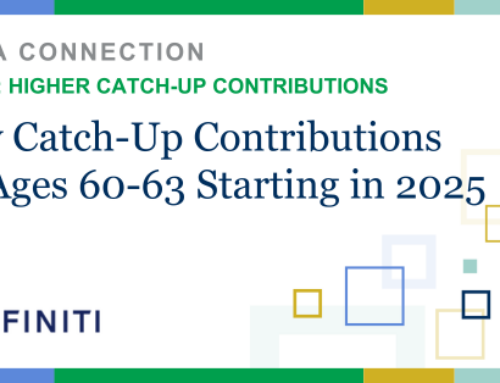Employers make company-match contributions to their employees’ retirement plan accounts for several reasons. For one, it can be an effective way to attract and retain employees since a retirement benefit is at the top of most employees’ “must-have” list. The company tax benefits are another reason a business funds a defined contribution (DC) plan match.
When an employee sees their employer offering a retirement plan match, it sends a message: My company cares about me and my future. If a company doesn’t provide a matching contribution, it can send the opposite message to employees and individuals considering jobs at the company: Is this the right place for me when I don’t get a company match in the retirement plan?
Company Matches are Popular — and Growing in Size
With the topic of retirement readiness regularly in the news, there’s an increased appreciation for the value of a substantial retirement nest egg. Many people understand company matches enough to know how these play a beneficial role in their nest-building.
Company contribution matches are a feature in most retirement plans today, though the match amount and other related factors vary from company to company. According to industry data, matching contribution amounts are on the rise, where employers are even more generous with the match contribution amount.
If you’re considering adding a company match for the first time or increasing the match contribution, there are a few things to know about this feature in a retirement plan.
Company Match 101
A match is a contribution an employer makes to a participant’s retirement plan account, such as 401(k) or 403(b). And as it is with many things about retirement plans, plan sponsors can customize the match feature to meet their organization’s goals for the plan.
The specific match structure is outlined in the plan document, including the company contribution amount, when participants are eligible for the match and when they become vested in the company contributions.
When establishing the match contribution, a plan sponsor will:
- Define who is eligible — that is, the employee’s required length of service, their age and their entry date to begin receiving the match.
- Match all or part of the employee’s contributions, pre-tax and Roth 401(k).
- Or make a nonelective contribution on an employee’s behalf, where the employee isn’t required to contribute to the plan to receive the match.
- Define the match as a percentage — for example, matching 50% of an employee’s contribution up to a certain percentage of their compensation, such as 6%.
- Or choose a specified dollar amount for the match, such as $1,000, rather than a percentage of the employee’s pay.
- Define the matching contribution as fixed, where the employer states the formula.
- Or define the match as discretionary, where the employer decides each year if they’ll make the match contribution and what that formula (or amount) will be.
- Choose when to make the match contribution — for example, regularly on a payroll basis (the most common option we see at Definiti) or once at the end of a calendar year.
- Revise the company match feature over time — A plan sponsor can change or even cancel the match contribution with an amendment to the plan document.
Safe Harbor Plan Matches
A safe harbor 401(k) is a popular plan type that many of Definiti’s clients use. Safe harbor plans help employers avoid most annual compliance tests and allow individuals designed as Highly Compensated Employees (HCEs) to save up to the IRS annual limit each year.
Safe harbor retirement plans generally use one of these options:
- 3% Nonelective – The employer contributes 3% of compensation, regardless of employees’ 401(k) deferrals.
- Basic match – The employer matches 100% of the participant’s first 3% of deferred compensation, plus a 50% match on deferrals between 3% and 5% (4% maximum match). The match can be enhanced to a more generous formula (up to 6% of eligible compensation).
- Match with automatic enrollment – Eligible employees are automatically enrolled in the plan. Employer matches 50% on deferrals between 2% and 6% (3.5% maximum match). The match can include Qualified Automatic Contribution Arrangements.
Matching Contribution Limits
Each year, the IRS states the annual limits for the contributions employees and employers may make to a retirement plan. For 2023, the combined total is $66,000.
Traditional, safe harbor and automatic enrollment DC plans allow additional catch-up contributions for anyone age 50 and older. For 2023, the catch-up maximum is $7,500.
The IRS also sets the annual limit for DC plans, including elective deferrals, employee contributions, employer matching and discretionary contributions. For 2023, the annual compensation limit for contributions is $330,000. (See chart with 2023 and previous years’ limits.)
SECURE 2.0’s Impact on Employer Contributions
In our recent ERISA Connection article, At Long Last, SECURE 2.0 Act Is Here, we outlined the omnibus spending bill that contained more than 90 provisions relating to retirement plan savings — including those that make a company match even more attractive to employers.
SECURE 2.0 also provides a new tax credit for the contributions employers with less than 50 employees make to a new retirement plan (other than a defined benefit plan). The new tax credit is a set percentage of the amount contributed by the employer as an employer contribution (as opposed to salary deferrals) for employees with annual compensation of $100,000 or less, up to a per-employee cap of $1,000. [For additional details, see the ERISA article’s Provisions Designed to Encourage Employers to Adopt 401(k)s section.]
Help Employees Maximize the Match
Industry studies show that only a small percentage of employees who are eligible for the match save enough to maximize it. A plan sponsor can help employees maximize the company contribution amount by encouraging them to save at least enough in the retirement plan to get the full match.
Plan design, such as automatic enrollment and automatic escalation features, can make a big difference in company match adoption. Participant education and financial wellness programs are equally important. And since prospective employees will be interested in the availability and generosity of a future employer’s retirement benefit, it’s wise to include retirement plan and company match specifics in job postings and new-hire onboarding materials.
Although it costs money to provide a company match, offering one can mean a federal tax credit for your business, setting your employees up for a better retirement and making your business more successful in the long run.
In this Definiti Academy video, we cover safe harbor 401(k) employer contribution options and explore ways to make the match work for plan sponsors and participants.
Helpful Resources
For more information about company matches in retirement plans, see:
We’re Here to Help
Definiti helps retirement plan sponsors and financial advisors explore innovative strategies for company match contributions, including using a safe harbor 401(k) plan. We advise on new-to-the-plan company matches and contribution adjustments by analyzing the benefits and ramifications of a company match specific to an organization’s retirement plan.
Our analysis helps plan sponsors:
- See how a company match addition or change aligns with current plan participation rates.
- Know how much the company match contribution will cost the business each year.
- Set targets for company match contribution adoption by employees.
If you’re ready to take the next step to add or adjust the company match in your retirement plan, let’s start the conversation. Call Definiti at 1-888-912-3653 or email sales@definiti-llc.com.



